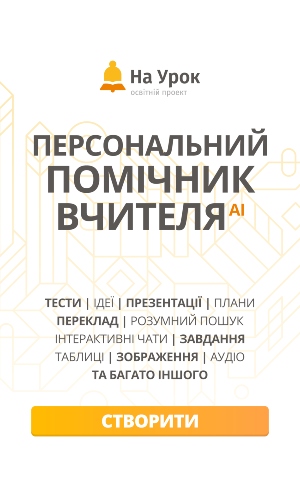Презентація "Defining Culture"
Анотація
Соціально-економічні зміни, що відбулися в Україні, масовий попит на спеціалістів зі знанням іноземних мов орієнтують нас, вчителів, на пошук нових технологій навчання, на вибір і використання найбільш ефективних з них.
Нашому суспільству потрібні творчо обдаровані особистості, і наше завдання як вчителів – розвивати здібності учнів. Вивчення і плекання творчих здібностей дитини – важливе завдання школи на сучасному етапі. Гармонійний розвиток дитини неможливий без її духовного збагачення та виховання творчої активності, тому творчість породжує творчість. Прагнення породжує пошук. Пошук таких форм роботи, які забезпечують максимальну активність всіх учнів протягом усього уроку, сприяють виділенню максимуму часу для говоріння кожного учня. Я звертаю увагу на різноманітні форми спілкування, створення сприятливого психологічного клімату в групі, зняття психологічних бар’єрів під час засвоєння мовного матеріалу та мовленнєвого спілкування. Це дає можливість залучати всіх учнів до навчальної діяльності.
Кожна людина мусить взаємодіяти із представниками інших культур. На жаль, дух нетерпимості, ворожості до іншої культури, способу життя, інакших вірувань, переконань, звичок завжди існував та існує надалі. Життя в полі культурному соціумі — проблема кожної особистості, групи людей і певних інститутів влади.
Усі люди різняться між собою. Одні мають білий колір шкіри, інші – чорний або жовтий. Одні люди високі, інші – невисокі. Одні стрункі, інші – повні. Люди звертають увагу на відмінності, але це не означає, що хтось є кращим за інших. Хоча в історії були випадки, коли лише через колір шкіри чи соціальне походження принижували інших людей, вважали їх гіршими за себе.
Так, люди своїми відмінними рисами доповнюють один одного.
Ми не схожі один на одного і, щоб мирно співіснувати, нам треба миритися з цим розмаїттям.
Дуже важливо сприймати людей такими, якими вони є, навіть коли їх уподобання відмінні від твоїх. Але інколи ми стаємо сліпими і не хочемо прислухатися до чужої думки і вважаємо свою думку правильною.
Ми живемо серед людей і повинні доброзичливіше ставитися одне до одного. Треба навчитися зважати на думки та вчинки інших, уміти зрозуміти людину й вибачити їй; бути дружелюбними; не робити іншим того, чого б ти не хотів для себе. А для цього необхідно викорінити зі своїх сердець зверхність, байдужість, упередженість. І світ стане кращим!!!
Матеріали “Defining Culture” можна використовувати як під час уроків, так і позаурочних заходах.
DIFINING CULTURE
Slide 1
Defining culture
Slide 2
Each personality is original and unique. Everyone has his or her own body and soul, there are many people who look alike but appearance, behavior and tastes are always individual. Such differences create your own culture.
Nowadays there are more than two thousand definitions of culture. The word culture has many different meanings. For some it refers to a good literature, music, art, and food. For example, for a biologist, it is likely to be a colony of bacteria or other microorganisms growing in a nutrient medium in a laboratory. However, for us, future social scientists, culture is an integrated system of learned behavior patterns that are characteristic of the members of any given society. Culture refers to the total way of life of particular groups of people. It includes everything that a group of people thinks, says, does and makes, its customs, language, material artifacts and shared systems of attitudes and feelings. Culture is learned and transmitted from generation to generation.
Slide 3
What Is Culture?
Culture is a way of life.
- Culture is shared by members of society.
- Culture shapes how we act, think, and feel.
Culture is a human trait.
- Although several species display a limited capacity for culture, only human beings rely on culture for survival.
Culture is a product of evolution.
- As the human brain evolved, culture replaced biological instincts as our species’ primary strategy for survival.
Slide 4
The Elements of Culture
Culture relies on symbols in the form of words, gestures, and actions to express meaning.
- The fact that different meanings can come to be associated with the same symbol (for example, a wink of an eye) shows the human capacity to create and manipulate symbols.
Slide 5
- Societies create new symbols all the time (for example, new computer technology has sparked the creation of new cyber – symbols). Language is the symbolic system by which people in culture communicate with one another.
Beliefs are specific statements that people who share a culture hold to be true.
Norms, rules that guide human behavior, are of two types:
- mores (for example, sexual taboos), which have great moral significance.
- folkways (for example, greetings or dining etiquette), which are matters of everyday politeness.
Slide 6
UNDERSTANDING CULTURE
Culture consists of the long-standing, largely implicit shared values, beliefs, and assumptions that influence behavior, attitudes, and meaning in a company (or society).
Slide 7
This definition has several important implications:
Culture is implicit.
People who share in a culture find their culture challenging to recognize. The most insightful cultural observers often are outsiders, because cultural givens are not implicit to them. Culture influences how people behave and how people understand their own actions. As a result, culturally influenced beliefs and actions feel right to people, even while their implicit underpinnings make it difficult for those people to understand why they act the way they do or why other ways of acting might also be appropriate.
Slide 7 (continue)
Culture is resilient.
Its elements are long-standing, not a matter of fads. The resilience of culture is supported by culture being implicit. It is difficult for people to recognize their own culture and how it exerts an influence on them. The staying power of culture is that it feels right to people; new cultural values that are imposed on people seldom replace their underlying values and beliefs in the long run.
Slide 8
How many cultures are there?
Thousands. Within any given nation there are many sub-cultures, and within many nations there are even completely independent cultures. There are a few hundred nation states in the world, multiply that by at least 10. Some people even believe every family has it’s own culture, after all, have you ever known two families that are alike in their roles and customs?
Slide 9
A lot of scientist were trying to explore how many cultures are in our world.
Political scientist Samuel P. Huntington divided the world into the 9 "major civilizations" .The main reasons of his devision are religion and cultural features of countries.
Slide 10
Hunington selects such civilizations
1.Western civilization, consists of the United States and Canada, Western and Central Europe, Australia and Oceania.
2.The Orthodox world of the former Soviet Union (excluding the Baltic states and most of Central Asia).
Slide 11
3.The Muslim world is representative by the Middle East, North Africa, Malaysia and Pakistan.
4.Hindu civilization, located mostly in India, Bhutan and Nepal, and culturally adhered to by the global Indian diaspora.
5.The Buddhist areas of Bhutan, Cambodia, Laos, Mongolia, and Thailand are identified as separate from other civilizations, but Huntington believes that they do not constitute a major civilization in the sense of international affairs.
Slide 12
6.The Sinic civilization of China, the Koreas, Singapore, Taiwan, and Vietnam. This group also includes the Chinese diaspora, especially in relation to Southeast Asia.
7.Japanese.
8. Latin american
9.The civilization of Sub-Saharan Africa located in Southern Africa, and Middle Africa
(American and Ukrainian cultures.)
So I want to tell you some facts about one of the most multicultural country - the USA.
The United States is widely known around the world as a leader in mass media production, including television and movies. The television broadcasting industry took hold in the United States in the early 1950s and American television programs are shown around the world.
Slide 13
The United States also has a vibrant movie industry, centered in Hollywood, and American movies are popular worldwide.
Slide 14
New York is home to Broadway and Americans have a rich theatrical history.
Slide 15
American folk art is an artistic style and is identified with quilts and other hand-crafted items.
Slide 16
American music is very diverse with many, many styles, including rhythm and blues, jazz, gospel, country and western, bluegrass, rock 'n' roll and hip hop.
Slide 17
The US is considered one of the more dynamic societies in the world. What’s meant by this is there is constantly new influx of immigrants into our culture. Approximately 10% of the population was not born here. So in the US those new immigrants bring their cultural backgrounds into the interaction in the culture. They welcome and pick up on many things in new cultures such as diet, art, music, patterns of behavior, language idiom, etc. While there is a welcoming of differences such as food and music, there is also a stress between new cultural influences and the predominant cultural influences. When people don’t understand each other, they become suspicious of one another.
Slide 18
To sum up, we all are different and have our own culture.
We have described only national culture, but we must realize that there are also subculture (punk, emo, rockers etc), and even family has its own culture. True, differences do set us apart--but we forget one thing: we are all human and our personalities are often different, even within the same subculture or family.
Slide 19
So, let's learn how to admire and even love our differences on the earth.
First - understand.
Realise that all people are different. Some are meaner, wiser, or nicer than others, but that shouldn't change how you treat people.
Second - observe.
Start conversations with people who are from different cultures, different places of the world, or who like certain hobbies and find out what makes them love it so much.
Third - respect. Study some history and traditions of other peoples of the earth, your country, or your home town. Be proud of your own culture, but also smile and admire other ways of life as examples of the diversity of the nations and regions of interest to you.
Accept these differences. Understand we are all human, and we all have our own opinions, habits and ways of life but we need respect each other for save this world.
Slide 20
WE MAY HAVE DIFFERENT RELIGIOUS, DIFFERENT LANGUAGE, DIFFERENT LIVES, BUT WE ALL BELONG TO ONE HEART


про публікацію авторської розробки
Додати розробку
